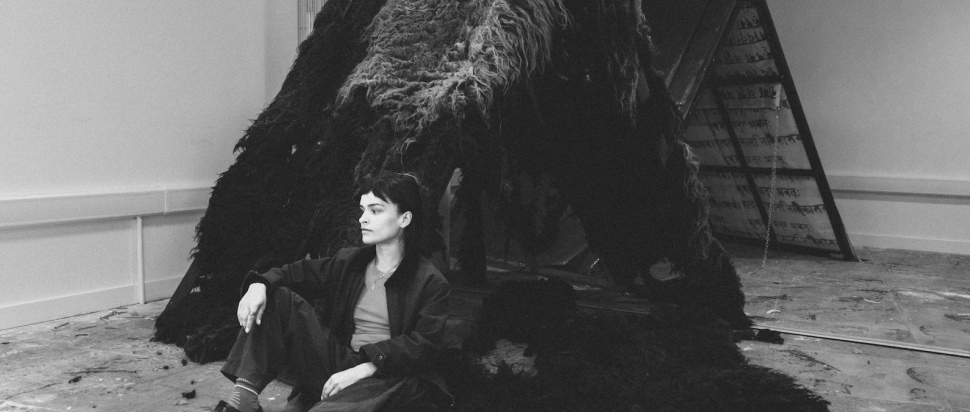Open Studio with Olivia Priya Foster
Every Saturday during Edinburgh Art Festival, Olivia Priya Foster will open up their studio to the public. We caught up with the artist about slow making, queer rurality and their works-in-progress
Olivia Priya Foster thinks of ontology, often. Their interdisciplinary practice concerns itself with how their being is related to that of the world around them. In particular, that world is rooted in the rural, responding to Foster’s childhood on a sheep farm in Argyll, as a queer artist of colour.
This year, Foster is here, there, and everywhere – and so too is their practice. Spring saw Foster win The Skinny Prize, as part of their work in RSA New Contemporaries. In July, we speak over a mildly glitchy video call while they’re on residency at Cove Park. This month, August, they return to their Glasgow studio and continue to settle into their new Edinburgh studio, provided for six months as part of Edinburgh Art Festival and Outer Spaces’ HOST residency. In October, they’ll take their practice to Sweeney’s Bothy for one week, as the recipient of the Visual Arts Scotland Residency 2025. One year out of art school and the Scottish art scene has called it, loud and clear: Foster is undoubtedly an emerging artist to watch.
Working from their laptop has been helpful during these months on the move. “Usually my work is born from collecting sounds and video, and then the installation element is built from byproducts of the film or material and objects that refer to the themes within the film and the audio work,” they say. For Foster, returning to Argyll usually demands a return to farm work; their residency at Cove Park has allowed them to spend time with their artistic practice in their home area.
Graduating with a BA in Painting and Printmaking from the Glasgow School of Art last year, Foster’s confidence in performance and installation work is somewhat unexpected. “I could never just automatically respond to a project or theme with paint,” says Foster, reflecting on the joy of the school’s open-ended degree boundaries. “I always wanted there to be a relationship between the themes in my work and the material that it's realised with.” Foster’s RSA New Contemporaries work Black Sheep (2025), for instance, sees Hebridean sheep wool draped across painting stretchers; a sound recording – collected audio from their family’s farm – plays from within the tent-like structures. Displacing natural materials subverts their very use and our perspective of such use.
“Usually, if I'm working with landscape, a way of getting material or using material in land will no doubt involve my labour,” says Foster. Capturing this labour on camera transforms it into a performance. These dual possibilities of a singular act excite the artist. For Foster, performance art does not demand an audience of thousands; the intimacy of their work is largely owing to a grounding in such home truths. Nor is performance the end result, brought into being at a prosecco-thirsty gallery opening; rather, performance is part of the process. Viewing their work through this lens of labour – both racialised and gendered – allows the artist to widen the scope of that very work. “Where does my intervention as the artist begin and end?” Foster remembers planting grass as a child; now, in their practice, that same grass grounds their recorded performances.
“Growing up on a farm, most of the projects that you see take decades to complete,” continues Foster. A similar acceptance grounds Foster’s work: they want a slow practice, one that takes its time to blossom. Fast fashion, Foster believes, has an artistic counterpart – poorly considered work, devoid of depth, is produced with commercial wins in mind. It is made, displayed, and packed away after meeting an audience once (or twice, if it’s lucky). Rather, Foster views their practice as one extended body of work. Recent considerations upon water cycles – how rivers separate land, who has the right to the land – are not distinct from their practice to date. For now, exhibiting is not front of mind; rather, Foster is sowing seeds.
Edinburgh Art Festival and Outer Spaces’ HOST Residency is integral to this period of growth. Every Saturday during the festival, the early-career artists welcome visitors into their studios. For Foster, it’s a fruitful opportunity: an open studio allows for open conversations. Outwith the confines of art school, such discussions with audiences are hard to come by – and therefore so too are the associated teachings. An artist’s developing practice is usually reserved for private studio visits and unseen funding applications; for an audience, playing witness to these early stages is a rare pleasure. Works-in-progress are works of art, all the same.
“I really want my work to be really accessible and not just appeal to, you know, a specific crowd, or an institutionalised crowd,” says Foster. Commercial art has its merits but Foster’s heart lies with community-based art. “There's nothing about my work that's really traditional.”
Coming to the end of our discussion, I ask Foster if there’s anything else they’d like to note. “Free Palestine.”
EAF X Outer Spaces: HOST, EAF Pavilion, 9-23 Aug, Saturdays 10am-5pm
